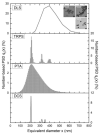Particle Detection and Characterization for Biopharmaceutical Applications: Current Principles of Established and Alternative Techniques
- PMID: 33228023
- PMCID: PMC7699340
- DOI: 10.3390/pharmaceutics12111112
Particle Detection and Characterization for Biopharmaceutical Applications: Current Principles of Established and Alternative Techniques
Abstract
Detection and characterization of particles in the visible and subvisible size range is critical in many fields of industrial research. Commercial particle analysis systems have proliferated over the last decade. Despite that growth, most systems continue to be based on well-established principles, and only a handful of new approaches have emerged. Identifying the right particle-analysis approach remains a challenge in research and development. The choice depends on each individual application, the sample, and the information the operator needs to obtain. In biopharmaceutical applications, particle analysis decisions must take product safety, product quality, and regulatory requirements into account. Biopharmaceutical process samples and formulations are dynamic, polydisperse, and very susceptible to chemical and physical degradation: improperly handled product can degrade, becoming inactive or in specific cases immunogenic. This article reviews current methods for detecting, analyzing, and characterizing particles in the biopharmaceutical context. The first part of our article represents an overview about current particle detection and characterization principles, which are in part the base of the emerging techniques. It is very important to understand the measuring principle, in order to be adequately able to judge the outcome of the used assay. Typical principles used in all application fields, including particle-light interactions, the Coulter principle, suspended microchannel resonators, sedimentation processes, and further separation principles, are summarized to illustrate their potentials and limitations considering the investigated samples. In the second part, we describe potential technical approaches for biopharmaceutical particle analysis as some promising techniques, such as nanoparticle tracking analysis (NTA), micro flow imaging (MFI), tunable resistive pulse sensing (TRPS), flow cytometry, and the space- and time-resolved extinction profile (STEP®) technology.
Keywords: biopharmaceuticals; emerging particle techniques; particle characterization; particle detection; particle quantification; protein aggregates.
Conflict of interest statement
The authors declare no conflict of interest. J.G.-R., M.B. and P.G. are from Boehringer Ingelheim Pharma GmbH & Co. KG, Innovation Unit., the company had no role in the design of the study; in the collection, analyses, or interpretation of data; in the writing of the manuscript, or in the decision to publish the results.
Figures










Similar articles
-
The application of STEP-technology® for particle and protein dispersion detection studies in biopharmaceutical research.Int J Pharm. 2018 May 30;543(1-2):257-268. doi: 10.1016/j.ijpharm.2018.03.050. Epub 2018 Mar 28. Int J Pharm. 2018. PMID: 29604370
-
Nanoparticle tracking analysis of particle size and concentration detection in suspensions of polymer and protein samples: Influence of experimental and data evaluation parameters.Eur J Pharm Biopharm. 2016 Jul;104:30-41. doi: 10.1016/j.ejpb.2016.04.013. Epub 2016 Apr 20. Eur J Pharm Biopharm. 2016. PMID: 27108267
-
Assessment of Tunable Resistive Pulse Sensing (TRPS) Technology for Particle Size Distribution in Vaccine Formulations - A Comparative Study with Dynamic Light Scattering.Pharm Res. 2024 May;41(5):1021-1029. doi: 10.1007/s11095-024-03698-y. Epub 2024 Apr 22. Pharm Res. 2024. PMID: 38649535
-
Particles in Biopharmaceutical Formulations, Part 2: An Update on Analytical Techniques and Applications for Therapeutic Proteins, Viruses, Vaccines and Cells.J Pharm Sci. 2022 Apr;111(4):933-950. doi: 10.1016/j.xphs.2021.12.011. Epub 2021 Dec 14. J Pharm Sci. 2022. PMID: 34919969 Review.
-
Measuring particle size distribution of nanoparticle enabled medicinal products, the joint view of EUNCL and NCI-NCL. A step by step approach combining orthogonal measurements with increasing complexity.J Control Release. 2019 Apr 10;299:31-43. doi: 10.1016/j.jconrel.2019.02.030. Epub 2019 Feb 21. J Control Release. 2019. PMID: 30797868 Review.
Cited by
-
A General Small-Angle X-ray Scattering-Based Screening Protocol for Studying Physical Stability of Protein Formulations.Pharmaceutics. 2021 Dec 28;14(1):69. doi: 10.3390/pharmaceutics14010069. Pharmaceutics. 2021. PMID: 35056965 Free PMC article.
-
Biophysical Characterization of Viral and Lipid-Based Vectors for Vaccines and Therapeutics with Light Scattering and Calorimetric Techniques.Vaccines (Basel). 2021 Dec 30;10(1):49. doi: 10.3390/vaccines10010049. Vaccines (Basel). 2021. PMID: 35062710 Free PMC article.
-
Recent Progress in Spectroscopic Methods for the Detection of Foodborne Pathogenic Bacteria.Biosensors (Basel). 2022 Oct 13;12(10):869. doi: 10.3390/bios12100869. Biosensors (Basel). 2022. PMID: 36291007 Free PMC article. Review.
-
FtsZ Interactions and Biomolecular Condensates as Potential Targets for New Antibiotics.Antibiotics (Basel). 2021 Mar 4;10(3):254. doi: 10.3390/antibiotics10030254. Antibiotics (Basel). 2021. PMID: 33806332 Free PMC article. Review.
-
Filamentous temperature sensitive mutant Z: a putative target to combat antibacterial resistance.RSC Adv. 2023 Apr 11;13(17):11368-11384. doi: 10.1039/d3ra00013c. eCollection 2023 Apr 11. RSC Adv. 2023. PMID: 37057268 Free PMC article. Review.
References
-
- Loureiro J.A., Gomes B., Fricker G., Coelho M.A.N., Rocha S., Pereira M.C. Cellular uptake of PLGA nanoparticles targeted with anti-amyloid and anti-transferrin receptor antibodies for Alzheimer’s disease treatment. Colloids Surf. B Biointerfaces. 2016;145:8–13. doi: 10.1016/j.colsurfb.2016.04.041. - DOI - PubMed
-
- Estep P., Caffry I., Yu Y., Sun T., Cao Y., Lynaugh H., Jain T., Vásquez M., Tessier P.M., Xu Y. An alternative assay to hydrophobic interaction chromatography for high-throughput characterization of monoclonal antibodies. MAbs. 2015;7:553–561. doi: 10.1080/19420862.2015.1016694. - DOI - PMC - PubMed
Publication types
LinkOut - more resources
Full Text Sources

